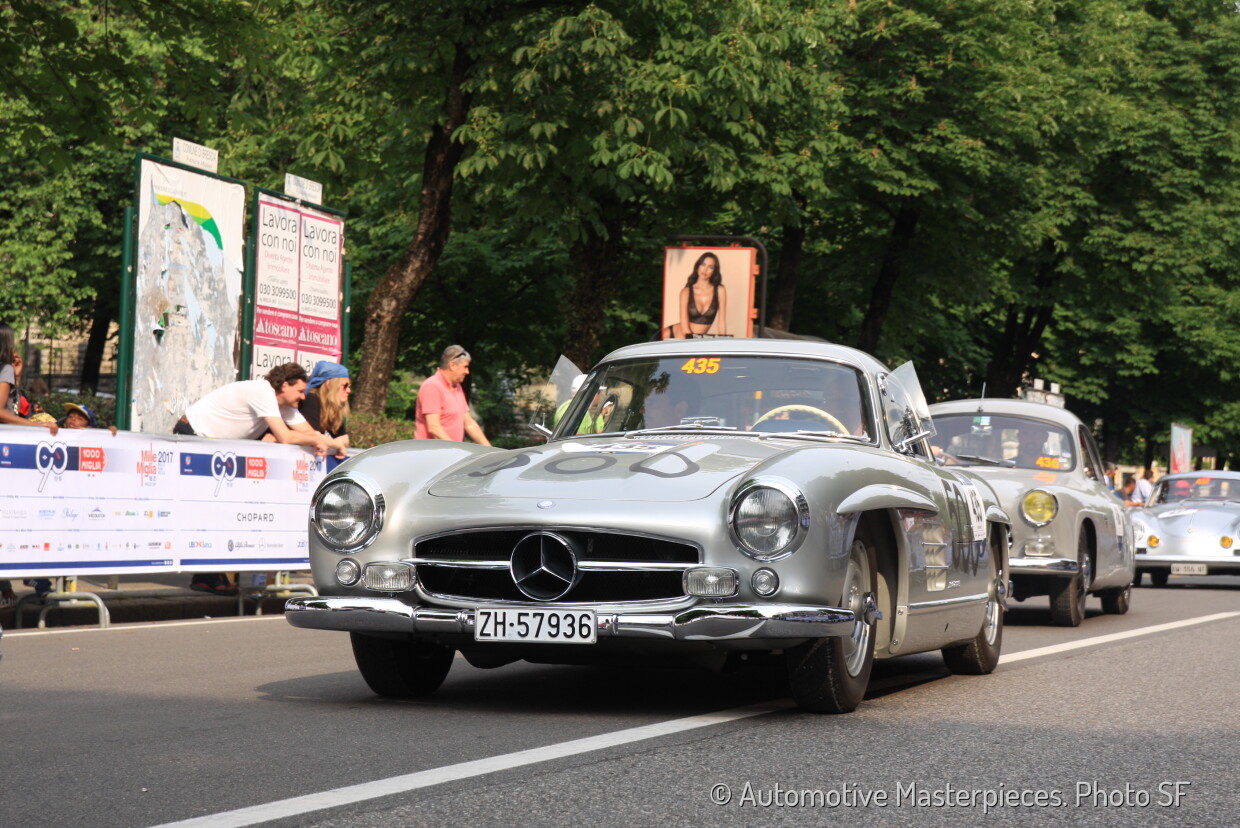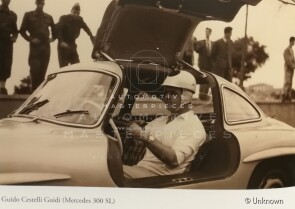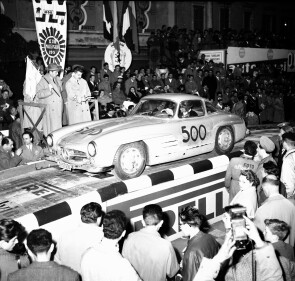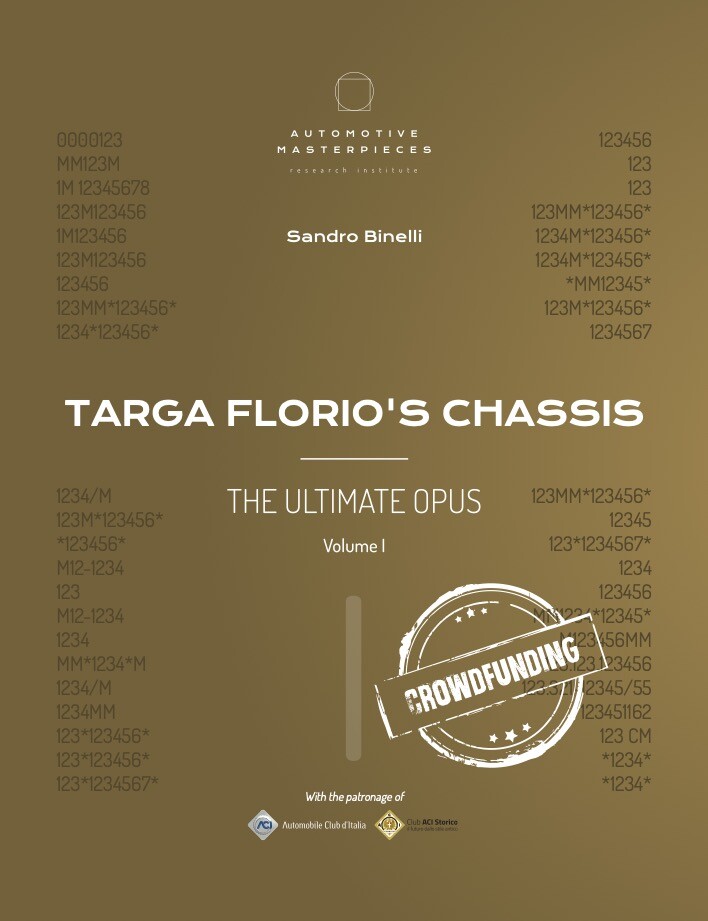
1956 Mercedes-Benz 300 SL
ON/OFF
Why am I an Automotive Masterpiece?
J. Movie cars
16th January 1957 Checkpoint (UK) Checkpoint is a 1956 British movie. The genre can be defined as a noir, a crime or a drama, it was directed by Ralph Thomas and starring Anthony Steel, Odile Versois, Stanley Baker, and James Robertson Justice. The film was shot at Pinewood Studios in London with locations in Italy, including footage of the 1956 Mille Miglia. The 198.040.6500028 appears in the race with the no. 500
Whilst Mercedes-Benz initially had no plans for series production of its racing (W194) 300 SL, its U.S. importer, Max Hoffman, had other ideas. Hoffman, a master marketer and a man of great insight, persuaded Daimler-Benz AG to offer a production model by ordering 1,000 of them to be sold in the United States. The idea was of a toned-down Grand Prix car, tailored to performance enthusiasts in the booming post-war American market. The new (W198) 300 SL, introduced at the 1954 New York Auto Show rather than the usual Frankfurt or Geneva shows, was both a grand tourer and the fastest production car of its days. This is the first of all the SL Mercedes Benz, where SL stands for Sport Leicht (Sport Light). It was built around an innovative aluminum tube spaceframe chassis, designed by engineer Rudolf Uhlenhaut, that saved weight while providing a high level of strength. Since it enveloped the passenger compartment, traditional doors were impossible, giving birth to the model's distinctive gull-wing arrangement. After a handful of early production models were made in alloy, as the competition cars were, the new Karl Wilfert and Friederich Geiger-designed body was largely steel, retaining aluminum doors, hood, and boot lids, and included the bumpers (with over-riders for U.S.-spec cars) and numerous comforts, including a tilt-wheel for ease of entry and featuring a sumptuous interior that is a requisite for Mercedes-Benz owners road use. Only 29 cars had an aluminum body designed for competitions, which for the 300 SL W198 were reserved for private drivers. For the engineering, the designers had to fight a lot to combine innovative ideas and performance needs with the difficult situation of German car builders right after the war, due to the rules and to economic conditions. A Bosch mechanical Fuel Injection replaced the race car’s carburetors: the unit, derived from the one used on the Messerschmitt fighter of World War II, on suggestion by Hans Scherenberg, a Daimler-Benz Avio engineer, raised the power output and would be the first for a production car. Like the W194, anyway, the W198 borrowed its 3.0 litre OHC straight-6 largely from the four-door 300 (W189), the famed "Adenauer" luxury tourer. Featuring an innovative aluminum head, with dry-sump lubrication, the engine was inclined to the side in order to reduce the height of the front end. The power, rated at 215 brake horsepower at 5,800 rpm (DIN) with the factory-optional or dealer-installed “sport” camshaft, was delivered through a four-speed manual gearbox. A 161 mph top speed and 0–60 acceleration of approximately eight seconds, depending upon the rear-end ratio selected from five options, made the 300 SL the fastest production automobile of its time. Aerodynamics played an important role in the car's speed, with Mercedes-Benz engineers placing horizontal "eyebrows" over the wheel openings to reduce drag. At high speed the car wasn’t easy to manage with the series-derived swing-axle rear suspension, nevertheless the W198 was an absolute winner when raced, beginning with the 1955 Mille Miglia, where was winner in class. With the 300SL, Daimler-Benz AG reaffirmed its prestige in those areas that had made it famous in the pre-war period, namely the class and elegance of its cars, but also their weight in sporting competition. Immediately successful and today iconic, when production ended after the 1957 model year, Hoffman’s original request for 1,000 cars was exceeded, as the production reached just 1,400 units. More than 80% of the vehicle's total production were sold in the U.S., making the Gullwing the first Mercedes-Benz widely successful outside its home market. In 1957 the 300SL began a new life as a roadster (W198 II), but this is another story.
1956 Mercedes-Benz 300 SL chassis 198.040.6500028 is peculiar, since it has a double story, as a race car and as a “pop-art icon”. It was one of the factory-prepared competition 300 SLs. The car was ordered and owned by Guido Cestelli-Guidi an experienced and capable racer, impressed by the performances of Armando Zampiero. The car was built for endurance racing, the Mercedes-Benz final assembly data card identifies this particular example built with competition “NSL” engine, competition suspensions, competition wider SLR type Rudge wheels and tires. The engine uses dual-point ignition, revised ignition and cam timing and a different fuel-injection metering unit which allows the engine to produce 250bhp rather than the standard 215bhp. Lighter weight is achieved throughout the car with details like an alloy starter motor rather than steel. Racing scaled instruments too are present: an 8,000rpm rev-counter and a 270kph speedometer. The car was heavily and successfully raced during the season 1956 and 1957, including two Mille Miglia, Targa Florio and Giro di Sicilia. In 1957 the car was registered in the name of Scuderia Campidoglio, where both Guido Cestelli-Guidi and his usual co-driver Giuseppe Musso (brother of the famous champion Luigi Musso) were members. An interesting note: another co-driver of Cestelli-Guidi was often his own wife. The car passed then in the hands of different owners until 1965 when Tony Russel, an Italian-American actor, discovered it by chance and purchased it. He felt that the old race car could help his image and acting career. Russel never raced the car and had problems finding competition replacements like the tires and high-octane fuel. The actor began somehow the “poster car” career of chassis 198.040.6500028. Still photos of Russel with the car have been taken by the famed Renaldo Tridici Studio in the beautiful Borghese Gardens in Rome. In the late ‘60s Russel returned to the U.S. with the car that, later, was bought by the 300 SL International Group President of the time, Mitch Leland. He entrusted a long and comprehensive restoration of the car in the hands of Scott Grundfor and Don Ricardo. The car came out in an astonishing red colour. Restoration completed, a renowned poster of this 300 SL was made and sold for many years through Mercedes Benz’s franchised dealers. In mid-1980s, to commemorate the centenary of Mercedes-Benz, the pop artist Andy Warhol was commissioned to do a series of paintings on the 300 SL Gullwing. His work was based on Leland’s red car original poster which Mercedes provided to Warhol rather to provide him with a vehicle. It was the first non-American designed object that Warhol had portrayed in his work. Several different versions of Warhol's work have had enormous diffusion and can be found in reproductions. 300 SL chassis 198.040.6500028, hidden in a private collection for a long time, is now on scene again at the main events, in its original silver-grey colour.









